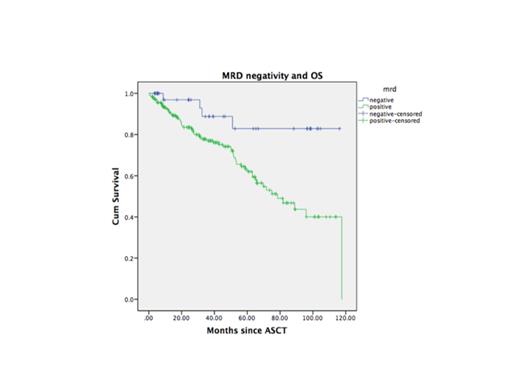Abstract
Introduction Preclinical and clinical data suggest that bortezomib in combination with high-dose melphalan (Bor-HDM) provides with a synergistic effect able to improve the quality of response for MM patients undergoing auto-SCT. In the present study, we aimed to assess the impact of Bor-HDM conditioning on ORR, and MRD negativity for MM patients undergoing single auto-SCT at our Institution.
Methods All consecutive patients who underwent single auto-SCT at Tom Baker Cancer Center (TBCC) from 01/2004 to 06/2015 using Bor-HDM or HDM as conditioning regimen were evaluated. Definitions of response and progression were used according to the EBMT modified criteria and a category of very good partial response (VGPR) was added. MRD negativity was assessed by multiparameter flow cytometry. All patients received induction chemotherapy before undergoing auto-SCT. Bortezomib was administered intravenously at 1-1.3 mg/m2 on days −5, −2, 1, and 4, while melphalan was given at 200 mg/m2 on day −1. A p value of <0.05 was considered significant. Survival curves were constructed according to the Kaplan-Meier method and compared using the log rank test.
Results Two-hundred and fifty-eight consecutive patients receiving Bor-HDM or HDM alone were evaluated. A total of 85 patients received Bor-HDM conditioning and 173 received HDM. Clinical characteristics and chemotherapy induction regimens are listed in Table 1. At day-100 post auto-SCT a ³VGPR was seen in 83.3% in the Bor-HDM group compared to 67.6% for HDM patients. The CR/nCR rate was higher in the Bor-HDM group (47.6% vs 23.6%) as well as MRD negativity assessed by flow cytometry (30.9% vs 9.7%, p=0.0001). Median OS in the Bor-HDM group was NR compared to 95 months for HDM alone (p=0.572), while median PFS was 39.3 months for Bor-HDM compared to 27 months for HDM (p=0.1). Median OS was shorter in the HR cytogenetic group regardless of the type of conditioning regimen employed (39 months vs NR for SR cytogenetics). In addition, patients who achieved MRD negativity, exhibited a longer OS (NR vs 78 months, p=0.007). Transplant-related mortality (TRM) was similar between both groups (p0.5).
In conclusion, Bor-HDM is a safe and efficacious conditioning regimen able to increase the nCR/CR and MRD negativity rates compared to HDM. Further studies are warranted to explore this regimen, especially when other upfront therapies are employed, with special view on the high-risk MM patients where response rates are good but sustainability remains an issue.
Clinical Characteristics
| Characteristic . | Bor/HDM, N=85 . | HDM alone, N=173 . |
|---|---|---|
| Age (median) | 58 | 59 |
| Gender Male Female | 51 (60%) 34 (40%) | 113 (65.3%) 60 (34.7%) |
| Hb (g/L) | 112 | 117 |
| Calcium (µmol/L) | 2.25 | 2.29 |
| Creatinine (µmol/L) | 85 | 80 |
| B2microglobulin (µmol/L) | 3.3 | 2.79 |
| Albumin (g/L) | 31 | 35 |
| Stage I Stage II Stage III | 15 47 23 | 61 73 33 |
| M-spike (g/L) | 34 | 30 |
| LDH (IU/L) | 194 | 180 |
| BMPC (%) | 40 | 33 |
| Heavy chain: IgG IgA IgD FLC only Biclonal IgM | 49 18 1 15 1 1 | 114 24 0 32 1 0 |
| Light chain: Kappa Lambda Biclonal | 50 35 1 | 124 47 1 |
| High risk Standard risk | 22 63 | 36 135 |
| Induction CyBorD VD Dexamethasone RVD | 45 24 0 16 | 16 54 43 15 |
| Characteristic . | Bor/HDM, N=85 . | HDM alone, N=173 . |
|---|---|---|
| Age (median) | 58 | 59 |
| Gender Male Female | 51 (60%) 34 (40%) | 113 (65.3%) 60 (34.7%) |
| Hb (g/L) | 112 | 117 |
| Calcium (µmol/L) | 2.25 | 2.29 |
| Creatinine (µmol/L) | 85 | 80 |
| B2microglobulin (µmol/L) | 3.3 | 2.79 |
| Albumin (g/L) | 31 | 35 |
| Stage I Stage II Stage III | 15 47 23 | 61 73 33 |
| M-spike (g/L) | 34 | 30 |
| LDH (IU/L) | 194 | 180 |
| BMPC (%) | 40 | 33 |
| Heavy chain: IgG IgA IgD FLC only Biclonal IgM | 49 18 1 15 1 1 | 114 24 0 32 1 0 |
| Light chain: Kappa Lambda Biclonal | 50 35 1 | 124 47 1 |
| High risk Standard risk | 22 63 | 36 135 |
| Induction CyBorD VD Dexamethasone RVD | 45 24 0 16 | 16 54 43 15 |
Overall Survival for patients with MM undergoing single auto-SCT according to the type of conditioning regimen
Overall Survival for patients with MM undergoing single auto-SCT according to the type of conditioning regimen
Progression-Free survival for patients with MM undergoing single auto-SCT according to the type of conditioning regimen
Progression-Free survival for patients with MM undergoing single auto-SCT according to the type of conditioning regimen
Overall Survival for patients with MM undergoing single auto-SCT according to MRD negativity assessed by flow cytometry
Overall Survival for patients with MM undergoing single auto-SCT according to MRD negativity assessed by flow cytometry
Jimenez-Zepeda:Celgene: Honoraria; J&J: Honoraria; Amgen: Honoraria. Duggan:Jansen: Honoraria; Celgene: Honoraria. Neri:Celgene: Research Funding. Bahlis:Celgene: Consultancy, Honoraria, Research Funding, Speakers Bureau; Johnson & Johnson: Speakers Bureau; Johnson & Johnson: Consultancy; Amgen: Consultancy; Johnson & Johnson: Research Funding.
Author notes
Asterisk with author names denotes non-ASH members.




This feature is available to Subscribers Only
Sign In or Create an Account Close Modal